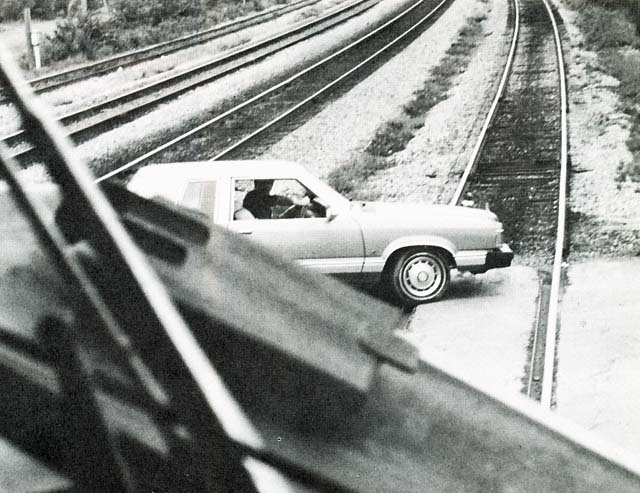|

Volume 13
Number 15
November 16, 1983
|
|
 |


A Futile Race: Scenes like this one, shown from the cab of a locomotive, are a daily fear of locomotive engineers.
Canadians Gamble a Lifetime
Each Year at Level Crossings
James had average marks in school and looked at life with the carefree innocence shared by many youths his age.
With his girlfriend at his side in his new car, James confidently charged a level-crossing in a race against an unwilling opponent, an approaching CP Rail
freight train.
His grandfather's rabbit's foot would ensure he-crosses first, he believed, but the charm would prove as lucky for James as it was for the rabbit.
James was taking the same gamble some 500 Canadians take unsuccessfully each year, often with fatal results. His story concludes a thought-provoking film
entitled "Gambling a Lifetime" which takes its audience from the humorous antics of the Keystone Kops to the real-life tragedies that result when
train meets car.
EDUCATIONAL TOOL
The 15-minute film was produced for Operation Lifesaver by Canadian Pacific's audio visual services under the direction of Assistant Supervisor Jim Wortley.
It was introduced last month as one of the educational tools used by Operation Lifesaver, a two-year-old national campaign designed to make the public aware of
the dangers of taking a chance at any one of Canada's 32,537 crossings.
Operation Lifesaver has also produced public broadcast announcements for television and radio and has published a children's railway safety booklet with
educational puzzles, games, and tests in a continuing effort to stimulate awareness of the dangers in trespassing on railway property.
(Anyone interested in obtaining some of the material, or use of the film, should contact their provincial safety league.)
The theme of "Gambling a Lifetime" and some of the footage was originally produced for a similar film by the Illinois Central Gulf Railway in 1925.
CANADIANIZED
Operation Lifesaver was looking for a vehicle to carry its safety message to a wide Canadian audience, especially impressionable teenagers, and Mr. Wortley
took on the challenge of not only updating the film with new footage but also "Canadianizing" it to make it more appealing to audiences in this
country.
It was a task that took Mr. Wortley, and Telescene Productions of Montreal, nearly a year to complete.
"We have worse problems in Canada than in the U.S. in that we are such a widespread railway, not only geographically but also seasonally different,"
said Mr. Wortley who, along with Supervisor Keith Baker, has been making audio visual presentations for training and safety purposes for about a decade at
Canadian Pacific.
CO-OPERATION
The production involved a lot of co-ordination and co-operation. Locations had to be selected to closely resemble the original footage and also the time of
year the original footage was shot.
"We had a lot of co-operation from our own operations people, as well as the local police forces, during the filming and without this co-operation we
would never have been able to do the job," said Mr. Wortley.
Meanwhile, Roger Cyr, national director of Operation Lifesaver, says the campaign to reduce accidents at rail/highway crossings is paying off in Canadian lives
saved and injuries prevented.
Crossing accidents reported by the federal Railway Transport Committee (RTC) in the first 10 months of 1983 were down 23 percent from the same period last year.
"This turnaround, from 536 accidents resulting in 65 deaths and 307 injuries to 412 mishaps involving 43 fatalities and 210 injuries, proved that our
efforts at educating the public about the dangers at rail/highway crossings are having a positive impact," said Mr. Cyr.
"It is particularly encouraging that the most significant reduction in crossing accidents has been in the areas of the country where provincial, regional,
and civic organizations have been most active in promoting Operation Lifesaver."
Quebec led the way with a 40 percent reduction in crossing accidents during the first 10 months of this year compared with the same period in 1982. Alberta and
Saskatchewan each recorded 35 percent reductions, followed by New Brunswick with 31 percent and Ontario with four percent. British Columbia was the only
province in the program to show an increase in level-crossing accidents during the 10-month period.
MAKING HEADWAY
There are still two provinces, Nova Scotia and Manitoba, where the program has yet to be launched. It will not be expanded to Prince Edward Island,
Newfoundland, the Yukon, and Northwest Territories because of limited trackage and low incidence of mishaps in those areas.
A project of the Railway Association of Canada and Transport Canada in co-operation with the Canada Safety Council, Operation Lifesaver aims to reduce the
number of crossing accidents by educating the public, encouraging stiffer enforcement of existing traffic laws, and improved upgrading and maintenance of
crossing warning devices. It is planned as a five-year program.
"The success of Operation Lifesaver has so far exceeded all our expectations," said Mr. Cyr. "Even so, there are still people being killed at
crossings, and there are countless near misses that go unrecorded.
"The great tragedy is that, with just a little more attentiveness, caution, and willingness by drivers and pedestrians to wait a few minutes at a
crossing, nearly all these accidents could be prevented."
This CP Rail News article is copyright 1983 by the Canadian Pacific Railway and is
reprinted here with their permission. All photographs, logos, and trademarks are the property of the Canadian Pacific Railway Company.
|